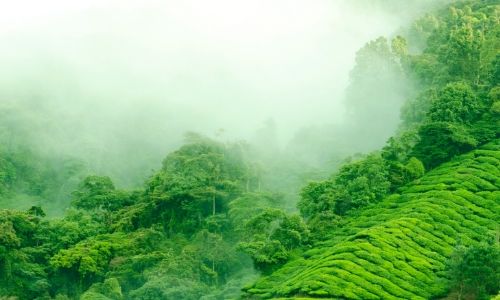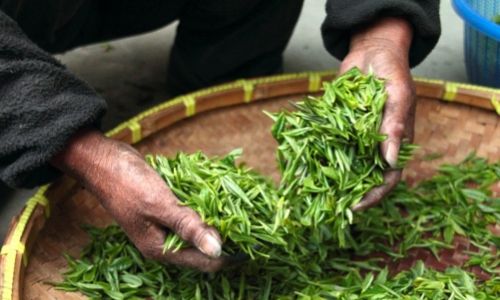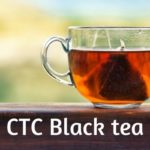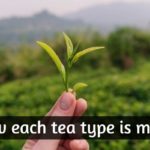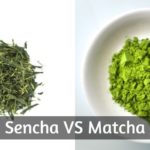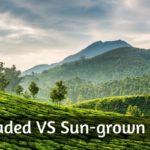If you're an avid tea fan then you've definitely heard of oolong tea. For those of you who, like me a couple of years ago, have no idea what oolong is, this guide will help you out.
I'll touch on the basic questions, and and a little extra. Starting with the first and most obvious question...
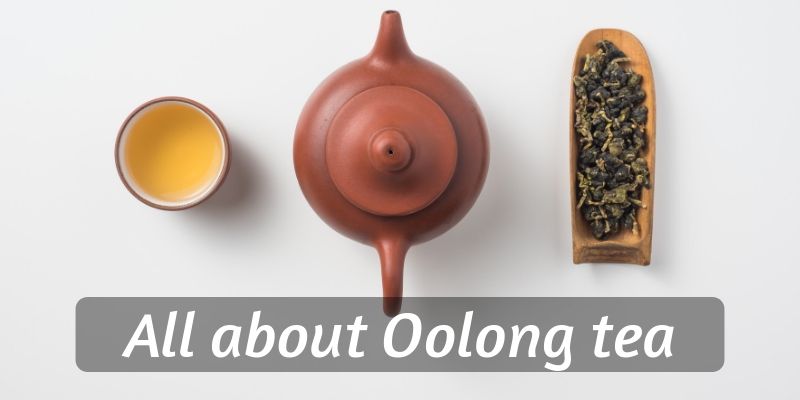
Table of Contents
What is oolong tea ?
Oolong tea is a type of tea, like black tea or green tea. It's made form the same leaves as any other true tea - Camellia Sinensis plant.
That is the ancient tea plant, and it's been used or tea making for thousands of years.
This tea is processed a bit differently than black or green or white tea. There are more steps to the process, and each one can drastically change the final taste of the tea you're about to drink.
This is why tea masters are able to produce, from the exact same leaves, several flavors of oolong, just by tweaking one step.
Oolong is about as old as black or green tea, so it has a tradition of its own. One of the traditions is how the oolong tea looks.
While most teas are simply leaves that have been dried and still look like long, dry leaves, oolongs are either rolled into tiny balls (pea-sized) or twisted into little spears which unfurl when brewing.
Perhaps the most famous oolong by sight is the jasmine pearl oolong. That is an oolong infused with jasmine scent, rolled into little balls. There are several types, and I'll touch on them soon.
Where does oolong tea come from ?
Originally the idea is oolong tea came from ancient China, as pretty much any other tea did. China used to have the monopoly on the tea trade, until the English wanted a share of the market.
Back to China, today most oolongs come from Taiwan or China. The main growing regions for oolong tea leaves in China are the Wuyi mountains, and Anxi county. Both are part of Fujian province.
This is important when you're reading the tea orogin on the box whenever you're buying oolong. The origin is always stated.
The Chinese oolongs are a bit more uniform, in that the weather in Fujian is more stable than the one in Taiwan, thus producing very similar crops each year.
As for Taiwan , much of the oolong (really any tea) produced in in the country is also bought and consumed in Taiwan. Some of it is exported to Western markets, perhaps the most famous being the Milky Oolong (Jin Xuan tea).
That's the tea that really blew my mind when I first had a sip. It tastes like butter, and maybe a bit smoky, and reminds me a lot of good Danish cookies.
Never add actual milk to Milky Oolong though, even if the name would have you think it fits It doesn't, and I ruined an entire cup of tea this way.
A short list of oolong teas (not near complete) might ring a bell for you:
- Jin Xuan/ Milky Oolong
- Da Hong Pao/ Big Red Robe
- Tieguanyin/ Iron Goddess of Mercy
- Dongfang Meiren/ Oriental Beauty
How is oolong tea made ?
The whole process of making oolong tea is what sets it apart from any other tea.
To start with, the Camellia sinensis leaves are picked and left to wither. Normally two leaves and a bud are used for making oolong tea. The leaves end up wrapping themselves around the bud during the process.
Withering tea leaves make for a start in the bruising and oxidation process. This is important for oolong teas, since much of the wonderful flavor stems from how much oxidation has taken place before the leaves are dried for good.
So oolong tea leaves are lightly rolled, shaken, placed in a wicker basket and shaken some more, anything the tea master can do to lightly twist and bend the leaves.
Once that's happened, the leaves are left to dry in the sun for a couple of hours. Once dry, they end up being very pliable, and then they are rolled for the first time.
Either they're rolled into the shape of a very small ball, pea-sized, or they are twisted into something resembling twist macaroni. In either case, this is only the first version, and is not meant to be keep tight.
The leaves are oxidized even more, and this contributes tot he final flavor of the tea. Now the tea master must decide how much he wants the tea leaves to be bruised. He can go for more, or he can stop at this point.
When he's reached a satisfactory version, he will then roast the tea leaves gently, on varying temperatures and for varying times. How much and how hot the roast is will affect the final taste of the oolong as well.
The point is that this process in irreversible, so once the tea master decides the oolong is 'done', roasting it locks in the flavor.
After roasting the leaves are left to cool a bit, and then they receive their second and final rolling or shaping. The little balls or twists are meant to be fairly tight so they can keep their shape.
And once the second rolling is done, the tea is simply left to dry completely and once that's done, it is packed and ready to ship.
At any point during the bruising, shaping, and oxidation process the tea master can change things up, or stop earlier, or insist more on some parts.
The final taste of the oolong will be severely impacted by this.
What leaves are used for oolong tea ?
The leaves for oolong tea are the same as the leaves of green, black, or white tea. Camellia sinensis - the tea plant - leaves are harvested mostly in the first part of the year.
This is because young leaves with one bud are preferred for oolong tea, and those are more commonly found in Spring.
The earlier in the year the leaves are picked, the lighter, fruitier, and generally pleasant the taste of the tea. As the year progresses the plants keep producing new buds and leaves, but they get an overall darker, maltier tone.
So the period in which the leaves are harvested, alongside the way the oolong is processed means that pinpointing an exact taste specific to oolongs is impossible.
Is oolong tea black or green ?
You might wonder if oolong tea is black or green in this case. It uses the same leaves as green or black tea, and it's roasted too.
As it happens oolong tea is not green, not is it black, nor is it white tea. Oolong tea is a category of its own, because it has a very complex processing method, and uses both the leaves for green tea and the ones for black tea.
This reflects in the multitude of flavors and brew colors available. Ranging from light, fruity tones with golden brews, to deep, dark maltier ones with a deep red brew.
Adding milk to an oolong is a shame, since it will disturb the delicate taste of the tea.
How do you brew oolong tea ?
Brewing oolong tea is much like brewing green tea. It needs water that is hot, but not boiling.
So you'll need 80 C/176 F water, and as much oolong tea leaves as you like to use. Keep in mind that about 2 teaspoons of leaves are good for 250 ml/8.5 fl oz of brew.
Once you've got your water hot enough you can either add the tea leaves in the water, and then strain once it's done brewing, or place the leaves in an infuser and place that in the water.
Whichever method you use, make sure to not leave the oolong for more than 3 minutes to steep. The tannins that are naturally present in tea will release more than they should, and lend a bitter, harsh taste to your cup of oolong.
Simply put overextracting your tea by using water too hot or letting it steep too long leads to bitterness, and an unpleasant cup of tea.
Another way to brew oolong tea is to use the Gongfu method. It's an ancient Chinese brewing method, and has a ceremony of its own.
In short, you have a very small ceramic infuser/teapot (called a Gaiwan), which can't fit more than a couple grams of tea at a time.
You fill the tiny teapot with a bit of tea, a bit of hot water, and let is brew for 10-15 seconds. The you pour out the brewed tea, and drink the resulting few sips.
Once those are done, over the same used tea leaves you can add another small amount of water, and let that brew for 15 seconds, and drink again.
All this until your tea leaves run out of flavor.
The Gaiwan is a great vessel to prepare tea in, and if you don't already have one at home you can check out this one by Li Da Tea House.
It's a small item, made entirely of ceramic and held together on one side with a bit of hemp.
This set contains the Gaiwan, the lid, and a ceramic cup to pour the tea into. It's a very efficient system, and will brew tea very nicely.
Serves 90 ml/3 oz, and the teacup can hold 50 ml/1.5 oz.
You can check the listing on Amazon here, and read the reviews as well.
Drinking tea Gongfu style not only adds an air of authenticity, but also kind of forces you to be there, be in that moment, and really be patient with your tea.
There is no rush with this ceremony, and consequently you're bound to learn to enjoy your tea even more.
As for a good oolong to enjoy, I recommend the Iron Goddess of Mercy. Sure the name might be a bit much for Westerners, but this is a very beautiful tea.
The Iron Goddess is actually one of the most precious Chinese teas, and a benchmark for quality oolong teas.
It should present a nutty, slightly sweet taste and you'll get a darker looking brew.
This set from Oriarm brings you 250 gr/8.8 oz of tea, and that will last you several months if you drink it ever day.
You can check the listing on Amazon here, and read the reviews as well.
Does oolong tea have caffeine ?
Yes, oolong tea does contain caffeine. It's made of Camellia sinensis leaves, and that plant itself contains lots of caffeine. It's its natural pest repellent.
So unless specified as being decaf, any tea made from this plant (and the Assam version) is caffeinated. This includes black, green, white, oolong, Pu'er tea and even matcha.
Exactly how much caffeine is in oolong tea, I can't tell you. It varies wildly from harvest to harvest, how young the leaves are, how long you let the tea steep, and even the tea master himself.
What I can tell you is that Camellia sinensis teas (except matcha) range at about ⅓ of the caffeine in a filter coffee. So somewhere around 40 mg caffeine/8 oz of brewed tea.
Matcha is a bit different, since you're ingesting the powdered leaves and this brings more caffeine into your system. Not all of it is processed by your stomach, but in general it's got a bit more caffeine than regular tea.
Final thoughts
When you're preparing oolong tea you might wonder about everything you've read. It really is a very complex tea, and there's no other tea like it.
And if you're thinking of using a Gaiwan, I'm sure you'll be very happy with the whole ceremony. It's a very tranquil and in-the-moment kind of experience, and your mind will be completely on the tea itself.
If you want to know more about coffee or tea, feel free to check the related articles below. Who knows what else you might find ?

